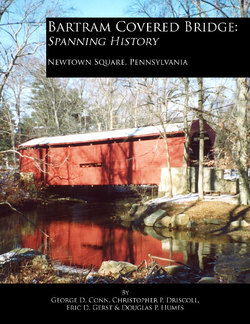Читать книгу Bartram Covered Bridge: Spanning History - George D. Conn - Страница 5
На сайте Литреса книга снята с продажи.
1 Early History of Bartram Covered Bridge
ОглавлениеAlthough Bartram Bridge was not built until 1860, the legal procedure was begun in 1859. The state Assembly had established specific procedures for erecting bridges. The counties were entrusted with carrying out those procedures. Bartram Bridge spanned Crum Creek, the border between Delaware and Chester Counties, and, thus, would involve the approval of both counties. For the purpose of simplification, the following narrative will follow the legal steps mainly through the Chester County records. The Delaware County records parallel those of Chester County, with minor changes in some dates.
The procedures for getting a bridge built, as specified by Pennsylvania state law, were as stated below. The responsibility for building the bridge rested with the County Commissioners, but the impetus had to come from the citizenry.
Local residents, businessmen, landowners, and whoever else would benefit from a proposed bridge, would draw up a written petition, sign it and present it to the County Court of Quarter Sessions. That court would then appoint a committee of respected residents to inspect the proposed bridge site and issue a report to the court on the merits of such a bridge. If the committee ruled in favor of the proposal, the County Commissioners would write up construction specifications and advertise in the local papers for people to bid on building the bridge. Once the bids were in, the County Commissioners would open the bids. As would be expected, the lowest bidder(s) would usually get the job of building the bridge.
Finally, when the construction of the bridge was completed, a Jury of Review was appointed to inspect the structure. If all the building specifications were found to have been met, the agreed upon amount was paid to the builder(s). If the construction was not satisfactory, then the builder, or builders, had to do additional work to meet the specifications. There were also occasions when the work was found a little “short” of expectations and the contractor(s) received a lesser amount than the sum originally agreed upon.
